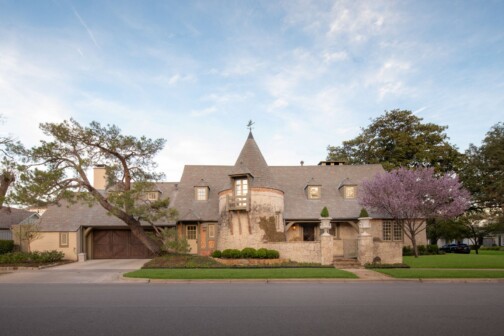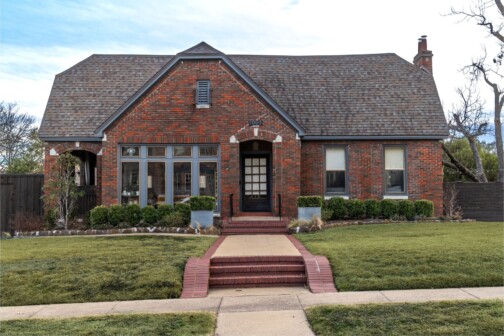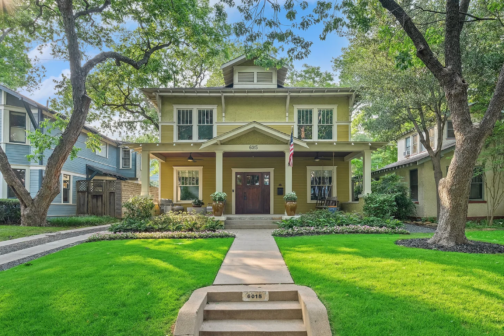On a whim in 2021, five fans of Charles Dilbeck drove down to Kerrville, Texas, where they’d heard a house by the famed Dallas architect was on the market. It was an unlikely group of self-proclaimed “Dilbeckians”—architect Nancy McCoy; Dilbeck’s daughter, Elaine MacIntire; former Westlake mayor Scott Bradley and his wife, Kelly; and former Dallas Park and Recreation director Willis Winters, who had been writing a book about Dilbeck for years.
During that trip, the Bradleys, who had already renovated (and moved) one Dilbeck house in Westlake, decided to buy and fix up the Kerrville property. And the five friends decided to form a “loose group” that would raise money to help Winters get his book off the ground, McCoy says. Then in 2022, they, along with other dedicated Dilbeck aficionados, officially formed the Dilbeck Conservancy, a 501c3 organization dedicated to the promotion and preservation of Charles Dilbeck’s residential and commercial architectural work.

On May 18, the organization is hosting its first-ever public event: a home tour of the “Four Sisters,” the nickname for the four Dilbeck-designed houses at the intersection of Shenandoah Street and Douglas Avenue in University Park. The houses are paradigms of the architect’s style, says Katherine Seale, former Dallas Landmark Commission chair and conservancy board member. She hopes the home tour will inspire “people to look and think about what it is that they like about homes and residential design—and Charles Dilbeck in particular.”
Born in 1907, Charles Dilbeck first began practicing architecture in his hometown of Tulsa, Oklahoma. During the Great Depression, he moved down to Dallas in search of more opportunity, and between the late 1920s and 1960s, he became one of the region’s most prolific architects. “There is no more iconic architect for Dallas than Charles Dilbeck,” Seale says.
Dilbeck was noted for his eclectic French Norman style, part of the storybook craze observed throughout the country post–World War I, Seale explains. In later years, he also was celebrated for his modern ranch houses. His designs were idiosyncratic and playful, says McCoy, the conservancy’s chair, who also notes that Dilbeck was never formally trained and therefore wasn’t bound by the constrictions of academe in his plans. The structurally sound rooflines could appear to be sagging, for example, or he’d use a drunken brick pattern on the facade. There would be turrets, large fireplaces, and multiple front doors—confusing visitors for just a moment on where to enter. It’s that personality, Seale and McCoy say, that makes his homes almost magical.

“I think that’s the reason why people are so passionate about it—because it’s so imaginative and whimsical that you can’t help but be attracted to it,” Seale says.
However, many of his buildings are getting to an age where, if they haven’t already been updated and renovated, they’ll become endangered, Seale says. There’s no way of knowing just how many Dilbecks have already been torn down, McCoy adds. It’s hard enough keeping track of the ones still standing. Dilbeck wasn’t the best record keeper, and while the conservancy knows of several hundred of his homes, a new potential house pops up about once a month or so. Take Kerrville. They visited one home in 2021, and knew about one other. Recently, they heard about a third Dilbeck down there. Says McCoy, “Who’s to say there’s not four?” The conservancy’s mission is to promote these houses and their characteristics in the hopes that homeowners will appreciate and preserve what they have.

The “Four Sisters” are some of the best—and earliest—examples of Dilbeck’s work in Dallas. Built between 1934 and 1936, three of the four houses are in Dilbeck’s French style and the fourth is an early ranch. Over the years, the houses have been listed in D Home’s “The 10 Most Charming Homes in Dallas,” and in 2022, Preservation Park Cities included them in its “Top 100 Significant Homes” list.
And while the houses have been featured individually on various home tours, they’ve never all been included on one tour. The conservancy wanted to make a “splash” for its first event, Seale says, and opening all Four Sisters to the public at one time was a “real coup.” Not only will it be fun for fans to get to wander through the houses, Seale says, “it’s a great way to introduce Charles Dilbeck to anybody who may not be familiar with his work.”
They plan to treat the tour day, May 18, a bit like a block party. There will be some light bites, plus cookies and coffee available for purchase, and a DJ onsite. Dilbeck’s houses are warm and cozy, Seale says, and they wanted to recreate that same vibe for the tour.

While the Dilbeck Conservancy initially formed to fundraise for Winters’ book, now their goal is to promote preservation through building community. “We are not necessarily going to stand in front of bulldozers,” McCoy says. “We’ve recognized that these are people’s homes, and as such, they need to be subject to some changes and to people’s personal preferences.” But they hope that through outreach and events like the home tour as well as a garden party they’re planning for this fall, they can help people appreciate the significance of Dilbeck’s work. If they appreciate his import, conservancy members figure, they’ll be more inclined to preserve those architectural characteristics that distinguish his houses from others.
It’s five fans’ humble effort to ensure Dilbeck’s legacy can carry on. After all, says Seale, “just drive around Dallas and in almost any part of town, you can see his influence.”
Author






